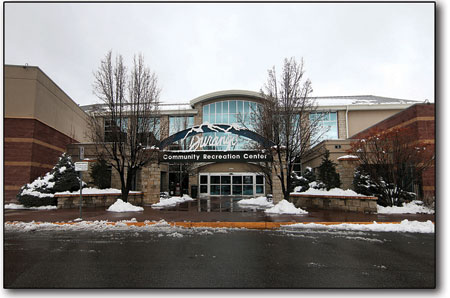 |
|
The half-cent sales tax approved by Durango voters in 1999 was used to pay for the construction and maintenance of the Rec Center, as well as the Animas River Trail./Photo by Jennaye Derge
|
Choice words
City Council hears ballot language for renewal of half-cent parks and rec tax
by Tracy Chamberlin
Over the next few months, Durango City Council is looking to reach out to residents about renewing a half-cent sales tax first approved by voters in 1999. “We need to get out and really make the case,” City Councilor Dick White explained.
The issue came up during a council study session Tuesday, when city staff presented the first draft of a ballot measure going to the voters on April 7.
Although time scheduled for the discussion was an hour, it only took half that for council to agree on supporting the half-cent tax. “I can happily say all City Council members are on board,” Mayor Sweetie Marbury said.
The proposed ballot measure hits several key points, including a reminder on the first line that it’s an extension of an existing tax, not a new one. It also refers to the Citizens Advisory Board, which offers input and recommendations on how the money is spent; the annual audit, which is already a requirement and part of the city’s desire for accountability; the length of the tax, through 2039; and the types of projects the tax would fund.
City Councilor Keith Brant said he thought it was important to let citizens know that the $125 million the tax is expected bring in, which includes its remaining lifespan plus a 20-year renewal term, is money that would otherwise come out of the city’s General Fund. “We need a third of this money just to maintain what we have,” Brant said. “I think that’s a really important point in all these presentations.”
Rec Center revenues taken in each year don’t cover the cost of maintaining the facility, which has a 90 percent cost recovery. The other 10 percent comes from the 1999 half-cent tax. With additional maintenance and improvement projects likely to crop up as the building ages, the gap between revenue and expenditures could grow. Without the half-cent tax, sources of revenue would potentially have to come from increased Rec Center fees.
“Maintaining what we have is real key to the City Council and to residents,” Marbury said.
From facilities at Lake Nighthorse to new lifts at Chapman Hill, it would take $219 million to pay for all the projects on the Parks and Rec to-do list. However, city officials are tasked with being specific on the ballot without filling page after page with that entire to-do list.
The umbrella terms used in the proposed measure would allow the tax to be used for a host of future projects laid out in the Parks and Recreation Master Plan, like Lake Nighthorse, the Animas River Trail or upkeep, maintenance and growth of the Rec Center.
Sales tax revenues on riseFive years after the financial fall, the numbers are looking good for Durango. Most revenues, including taxes, dropped into the red in 2009-10. Since then, they’ve slowly been on the upswing. A truth not just for the nation, but Colorado and the Southwest as well. As of November, sales tax revenues for the City of Durango were up 4.8 percent over the year previous. The lodgers tax was up almost 12 percent. “The whole state is doing well,” explained Julie Brown, Director of the Finance Department. December numbers aren’t expected until later this week, but the sales tax revenues have been up for the month of December every year for the past five years. This one isn’t likely to be the exception. Brown doesn’t see the current economic upswing changing anytime soon, either. With gas prices so low, it might even make Durango easier to visit. “We’re a very big drive-to location for visitors,” she said. – Tracy Chamberlin |
It’s been about a year since Parks and Recreation Director Cathy Metz brought the half-cent sales tax initiative before City Council. The first public outreach was April 2014 when the Parks and Recreation Department hosted a community meeting. The attendees were supportive of the renewal efforts, according to Metz.
Since then, the city reached out online via its Virtual City Hall, which featured an open comment section, informational links, survey and demographic data. With 712 visitors, three times what any other topic received, and 507 open comments, there was no shortage of feedback.
The online survey asked residents if the city has done a good job of using the funds raised from the 1999 tax, what Parks and Rec projects they would like to see funded, and whether or not they would vote to approve the renewal.
Overwhelmingly, residents said the city had done a good job spending the funds taken in. Out of the 16 options for how the future monies could be spent, Animas River Trail projects came out on top. But only by a narrow margin.
As for whether or not the 248 residents who responded to the questionnaire would support renewing the tax, 65 percent said they would “definitely” vote yes and 25 percent would “probably” vote yes.
Although few residents have voiced opposition to the tax, city officials are not making any assumptions.
“The lesson we learned with the LPEA franchise fee was: Don’t take anything for granted,” City Manager Ron LeBlanc said at Tuesday’s study session.
In 2012, Durango voters turned down a renewal of the fee, and the city was forced to try again that November.
“Even though there’s a track record, we can’t assume everyone’s going to agree,” he added.
To learn more about the half-cent sales tax, visit www.duran gogov.org. Check out Virtual City Hall and click on Closed Topics, or Parks and Recreation Dept. and click on Future Parks and Rec Expenditures.
